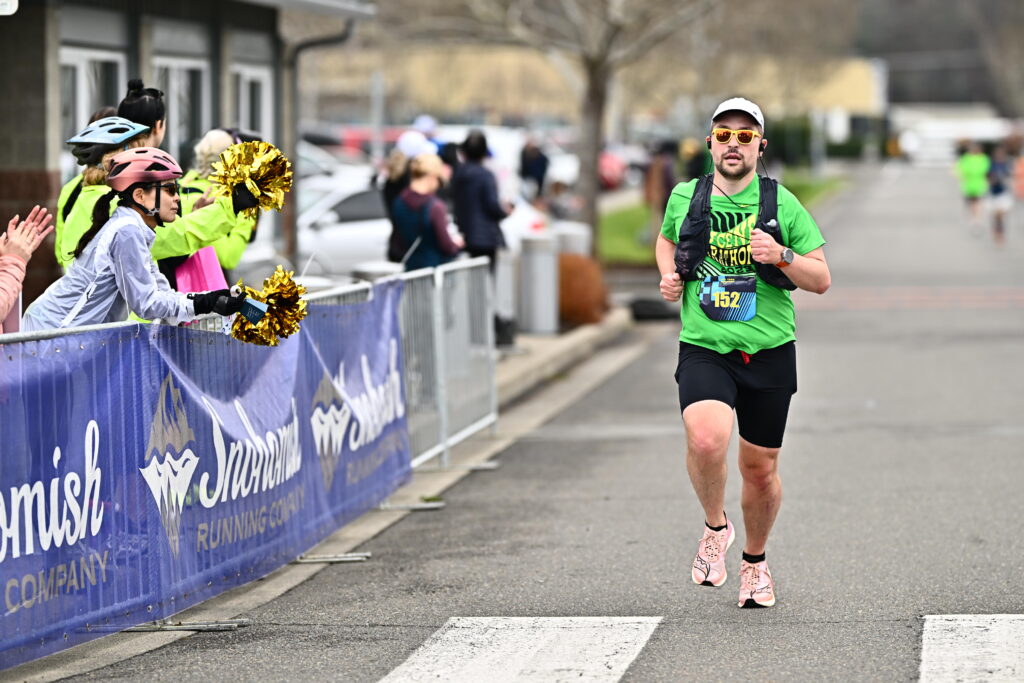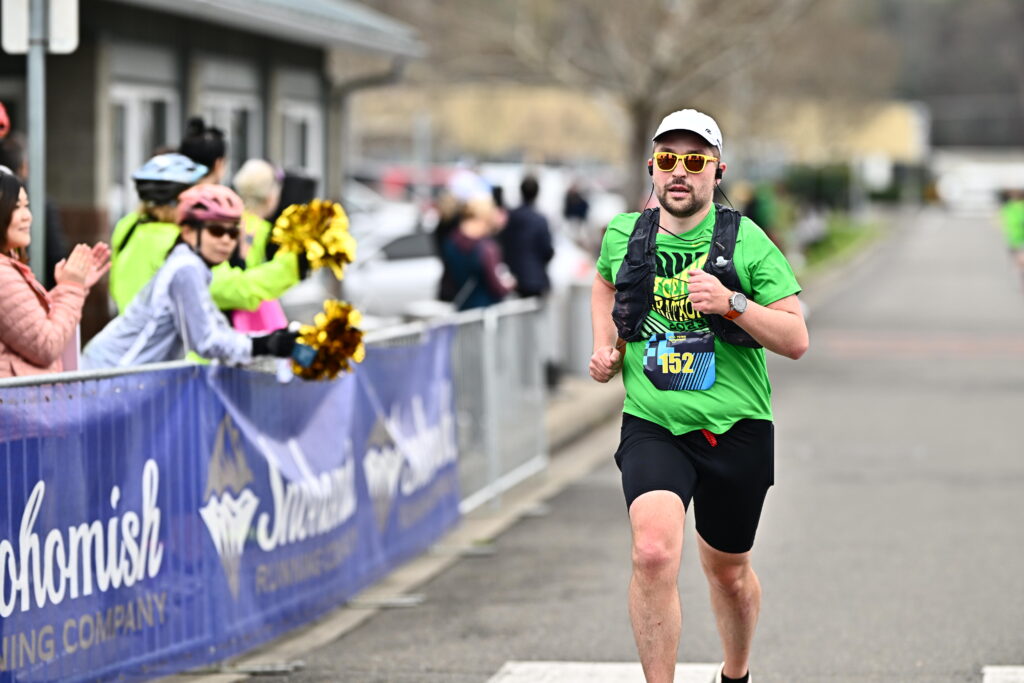On March 24, I ran Mill Town Marathon, a local race, which was my third marathon (after Seattle back in 2022 and Philly four months ago). I managed to PR by more than 7 minutes with the time 3:26:43 (Strava activity), despite quite significant elevation gain (900+ ft according to the watch) and despite this race “merely” being a training race for the upcoming Comrades marathon. But more importantly, as any race, this was an opportunity to remind myself that I can and love doing truly hard things, and it’s always nice to exercise this “muscle”.
In this post, I will describe my training structure leading up to the race and provide the coverage for the race day itself.
Training
Here is what I did differently for this marathon compared to the previous two iterations:
- Higher volume. One of the most important variables that predict performance in middle- and long-distance races is the training volume. For Comrades, I started routinely running 60+ miles a week (plus some cross-training, see below). For the previous two marathons, I had maybe a couple of peak weeks in this range (here is a specific training breakdown for my first marathon), but now it became the new normal. High volume / low intensity approach works quite well for me, and for now I really enjoy running far and long (I often tell people that my main reason to train so much is to be able to enjoy my weekly long runs).
- “Easier than easy” effort. In order to be able to sustain higher volume, I intentionally held myself back on most of the easy runs. It was not atypical that my average heart rate was in low–mid 120s (my max heart rate is around 190). This allowed me to adapt to higher volume much better and not be constantly sore or fatigued. People constantly talk about “Zone 2 training”, but currently for me the boundary between Zone 2 and Zone 3 is about 8:15–8:25 per mile, and if I tried to run with this pace 60 miles a week, it would immediately destroy me. So, Zone 1 is where it’s at (for most of the runs). I’m definitely lucky that I can still run with fairly decent pace (9:30–10:00 per mile) while keeping very low heart rate, so the run does not turn into a slog and my running form does not particularly break down.
- Cross-training (cycling) double during the work-out day. One other way to boost the training volume without increasing the risk of injury much is to add some aerobic cross-training: swimming, cycling, elliptical etc. My coach added the second PM cross-training session on Wednesday, which is my work-out day. Initially, this sounded a bit ambitious to me, but it turned out that if I spin the bike for 30 minutes in the evening of the work-out, the next day my legs feel much better, while getting an additional aerobic stimulus. For cycling, I use my beloved trainer Wahoo Kickr Core, which I got back in 2020.
- Explicitly eating enough carbs, protein and fat (especially during the “long” days). I started to pay attention to the particular breakdown of what I’m eating in terms of macronutrients. If one cares about their performance in endurance sports, it’s crucial to eat enough protein, carbs and fats, particularly on the “high-volume” days. I don’t want to talk about specific numbers, since I’m not an expert and it’s a bit of a delicate topic, but let me just say that I had to rebuild intuition on what constitutes “enough” food during training, and how it should be split into macronutrients.
- Focus on tempo runs and threshold intervals. On the topic of specific work-outs, the last couple of months I was doing mostly tempo/threshold runs: sometimes continuous, sometimes threshold intervals. The exact impact of such focused block is hard to measure, but subjectively, it made the marathon pace feel way easier.
- Progression long runs. One modification to moderate long runs that I really enjoyed this time is progression runs, when you start with an “easier than easy effort” and gradually work your way towards the last couple of miles at half-marathon effort or might be even a touch harder (around the threshold effort). I doubt such runs have a particular phisiological benefit, but they definitely teach you to run fast on tired legs from the mental point of view.
Race
Before the race
I did some amount of carb loading, but not too much: I emphasized carbs two days leading to the race. My favorite pre-race dinner is short-grained rice with melted American cheese (please don’t judge). If I overdo carb loading, I tend to feel bloated and start having GI issues, luckily was not the case here.
On the morning of the race, I ate some solid food (a Clif bar) and most importantly, consumed some caffeine (grande americano from Starbucks). Given that I had not had caffeine for almost four months in any form, this was a bit risky from the GI perspective, but for now it made me feel super-well and ready to go.
Right before the start, I did a short warm-up (10 minutes easy run), which was a welcome change from Philly, where I had no time to warm-up properly due to lines to the bathrooms.
I was firing on all cylinders and ready to go.
During the race
The weather was perfect: around 9C (48F) and almost 100% overcast. The race was very small (just 146 finishers, compared to 11000+ for Philly), which was great, since it allowed me to run decent tangents and not waste precious meters or running around people.
Given that this was meant to be a tune-up race, I decided to go out fairly aggressively and see what happens, understanding that there was a possibility of blowing up. I decided to start with a 3:30 pacer group and then assess how I feel a few miles in.
A couple of weeks before the race I restarted doing mindfulness meditation. I’m a huge fan of it [though I tend to drop the ball from time to time and need a nudge to restart], but during the race I realized that it has huge benefits for running as well. While racing, I tend to have issues with my “lizard brain” freaking out about the future and begging me to slow down. This time I argued with it as follows: “Ilya, focus on the present moment. Do you feel acceptable now? If so, you can continue running fast. Don’t worry how you’ll feel in an hour. If you feel bad then, you can slow down. But in an hour, not now, while you are still feeling decent.”
Amazingly, this “feeling bad an hour later” never happened and I managed to run an almost perfectly even (slightly negative) split: 1:43:33 + 1:43:10.
It’s hard to estimate the effect of caffeine in isolation, but my feeling was that it really affected the RPE (rate of perceived exertion) and paces that felt moderately hard in training felt very easy on a race day. But then again, there were many other factors that might have affected it.
Race fueling was already quite standard for me: 240 calories of (caffeine-free) GU gels per hour (800+ calories overall) plus water with tuned concentration of electrolytes [specially, Liquid IV]. Everything went down very easily and obviously helped a lot: no signs of cramps or severe dehydration. When I ran out of water, I stopped on a couple of aid stations and picked up some carb drink they provided. For me, it always makes sense to do it: it’s better to lose a few seconds here and there than to blow up towards the end.
Overall, I ran well and didn’t fade, and even managed to run the last few hundred meters with sub-7:30 pace. Last few miles felt a bit rough on my quads and calves, but that’s where the practice built by progression long runs kicked in, and I knew I should be able sustain the pace even on the depleted and fatigued legs.


These are the pictures from the finish line. People told me I looked fairly fresh, and I could run decently fast, but I was in the world of pain (but in a good “type-2 fun” way).
After the race
Despite caffeine helped me a lot during the race, the night after and the next day I had pretty severe symptoms of the caffeine withdrawal (anxiety, poor sleep, feeling down in general). A good reminder why I don’t normally consume caffeine. Thankfully, by Tuesday it was gone almost completely.
Recovery so far is going in a more or less standard way. The race was on Sunday. On Monday and Tuesday my legs (especially quads) were pretty sore and I had to walk downstairs backwards. On Wednesday I felt mostly fine and could do some cross-training and on Thursday I was already able to run and felt quite OK. Still according to my previous experiences, it will take me a couple more weeks to be 100% back to normal.
Conclusion
Overall, it was a great experience that served as a confidence booster for my Comrades build. When training, I sometimes have long runs or work-outs where all the stars align and I yield performances that are much better than typical ones. This was probably the first race when it happened, but it’s important to remember that such “outliers” are precisely representatives of the true fitness.